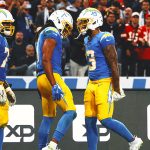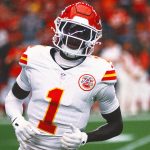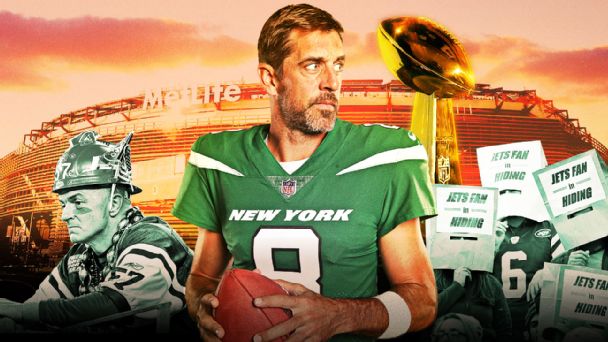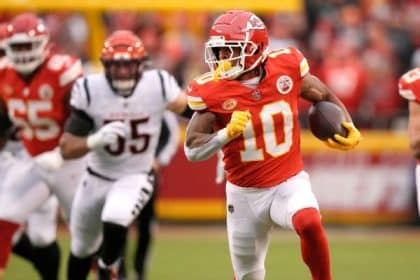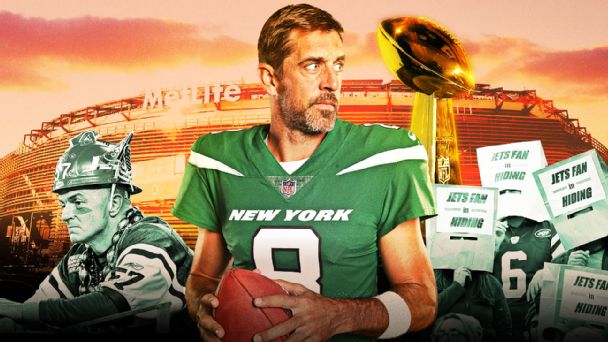
FLORHAM PARK, N.J. — A small corner of the big city came to a virtual stop at noon on Aug. 30.
A barricaded crowd on the sidewalk outside the Ziegfeld Ballroom on West 54th Street in Manhattan buzzed with anticipation as the New York Jets‘ buses, led by a police escort, pulled up for their annual kickoff luncheon. Out stepped their new starting quarterback, Aaron Rodgers, wearing dark shades and exuding “VIP” as he walked the Jets green carpet with fans screaming his name.
“It was like we were some sort of pop band or something — a boy band,” he said later. “There were a ton of fans, just like paparazzi. It was incredible, just the energy. But it’s like that wherever we go. … That’s how it’s been since Day 1 when I got here.”
From Day 1 to Day 138, Rodgers has been a star on a mission to change more than a half-century of bad Jets karma. A franchise that has endured the Butt Fumble, the Fake Spike, the Sucker Punch and too many quarterback-related calamities to count believes it finally has the right person at the most important position in sports. For a change, the Jets are on the carpet and inside the velvet ropes, not gawkers on the outside.
The Jets last played in the Super Bowl on Jan. 12, 1969, a few months before Woodstock, led by Hall of Famer Joe Namath. This year, they created their own Summer of Love, watching as a rejuvenated Rodgers, 39, galvanized a team of young stars and older veterans with his hugs-and-handshakes style of leadership. Ultimately, he wants to duplicate what a 43-year-old Tom Brady did for the Tampa Bay Buccaneers in 2020.
Win a Super Bowl.
“I visualize that all the time,” said Rodgers, who debuts Monday night against the Buffalo Bills at MetLife Stadium (8:15 p.m. ET, ESPN/ABC/ESPN+).
The Jets have tried this before, importing an older, accomplished quarterback to lead them out of the darkness — Boomer Esiason, Neil O’Donnell, Vinny Testaverde and Brett Favre, to name the most prominent. Only Testaverde got within an arm’s length of the Lombardi Trophy.
Now it’s on Rodgers, who knows a thing or two about darkness, to change the “Same Old Jets” narrative and get them to a championship.
A FEW WEEKS after Rodgers was traded to the Jets, Namath sat at his kitchen table in Tequesta, Florida, imagining the possibilities.
Broadway Joe, who attracted sidewalk crowds and plenty of paparazzi in his day, is the patriarch of Jets quarterbacks. As such, the Super Bowl III MVP always gets asked his opinion of the current quarterback, whether it’s a recycled veteran or a shiny draft pick such as No. 2 overall pick Zach Wilson, who was replaced after two seasons. Ever the optimist, Namath usually keeps it positive even if he does have concerns.
With Rodgers, he doesn’t have to manufacture optimism. It’s real.
“I’ve never seen anyone better,” said Namath, his voice rising at the table. “Brady has the championships — seven Super Bowls. That’s remarkable. But Aaron, watching him, his athleticism, and the way he moves around out there, nobody has ever done it better than him.
“As we know and believe, he’s making them a contender right now. They have the defense and they have the offensive standout guys. If he plays anything like he’s played in the past, they’ve got a shot, a real shot.”
Except for an occasional spasm of success — four trips to the AFC Championship Game in the post-Namath era — the Jets have ranged somewhere between punching bag and also-ran over the past five decades, in large part due to substandard quarterback play.
Of the 36 quarterbacks who have started since Namath’s last year in 1976, one has won more than 40 games — Ken O’Brien, who won 50 starts from 1984 to 1992.
One quarterback drafted by the Jets in the past 30 years has been selected to a Pro Bowl — Geno Smith, who did it last season with the Seattle Seahawks. His time with the Jets was defined by one inglorious moment — a 2015 locker-room punch by teammate I.K. Enemkpali, who broke Smith’s jaw and derailed his career in New York.
Esiason, a former NFL MVP and AFC champion with the Cincinnati Bengals, saw his Jets run unravel with a late-season loss in 1994 to the Miami Dolphins, who won in the final seconds when Dan Marino tricked the Jets by faking a “clock” play and throwing a touchdown.
Esiason, who had a costly interception, felt the wrath of the fans on the way home, when he stopped to help a motorist who was involved in a fender-bender. Recognized instantly, he got cursed out by the woman for blowing the game. So much for being a good Samaritan.
The Jets lost 32 of their next 36 games.
O’Donnell, fresh off a Super Bowl appearance with the Pittsburgh Steelers, was sacked by the Jets’ logo in a classic “Same Old Jets” moment. In 1996, while warming up on a wet field, he slipped on the painted logo in the end zone and tore a calf muscle. That pretty much symbolized his ill-fated, two-year stay in New York.
Favre, acquired just before the 2008 season in a trade with the Green Bay Packers, had the Jets thinking Super Bowl with an 8-3 start. Then teammates noticed a decrease in velocity on his passes. As it turned out, the legendary gunslinger had a torn biceps tendon, never revealed by the team. He played through it, but he was noticeably diminished. So were the Jets, who missed the playoffs with a spectacular collapse.
The Jets had a good one in Chad Pennington, whom they drafted and developed in the early 2000s, but he was undermined by multiple shoulder injuries. Mark Sanchez showed promise in his first three seasons, helping the Jets to the AFC Championship Game in 2009 and 2010. Then came The Butt Fumble in 2012, and his career was never the same.
Into this quarterback graveyard walks Rodgers, the most accomplished in franchise history — four MVPs and one Super Bowl championship in 18 seasons with the Green Bay Packers. He has 10 4,000-yard passing seasons, compared to one for the entire Jets organization (Namath, 1967). This is akin to Bill Gates being hired to run the help desk at the local computer store.
Rodgers does have questions to answer, though. He’s coming off a season in which he posted a career-low 39.3 Total QBR. His deep-ball accuracy is on a two-year decline. On throws of 20-plus air yards, his completion rate went from 44% (2020) to 39.4% (2021) to 33% (2022), according to ESPN Stats & Information data.
But in training camp, Rodgers dazzled teammates, coaches and onlookers with his uncanny accuracy and command of the huddle.
“You’re watching brilliance — and we haven’t seen a lot of that over time,” said Esiason, who believes “100%” that Rodgers can deliver a Super Bowl.
Testaverde agreed.
“Aaron Rodgers is the right man for the job,” he said. “He can handle New York — not everyone can — and he’s definitely at the top of his game still. You talk about Patrick Mahomes. Aside from him, [Rodgers] is probably the best quarterback out there right now.”
Testaverde was 35 when he led the Jets to the AFC Championship Game in January 1999. With Hall of Fame coach Bill Parcells on the sideline, and with future Hall of Famer Bill Belichick calling the defense, they held a 10-0 lead over the Denver Broncos in the third quarter. Thirty minutes from the Super Bowl, they fell apart by allowing 23 unanswered points.
The following year, the Jets opened as one of the favorites in the AFC, but the season was over soon after the fans settled into their seats for the first game. In the second quarter, Testaverde ruptured his Achilles tendon. The sight of Testaverde being carted off with a towel covering his face still haunts Jets fans.
Reflecting on that fateful day, Testaverde said, “My first thought was, ‘Man, I wish we got it done the year before.'”
Playing quarterback for the Jets means always having to wonder what might have been.
JOE KLECKO, A new member of the Pro Football Hall of Fame and one of the most beloved players in franchise history, didn’t want the Jets to make the trade. In multiple interviews, Klecko said he was worried about Rodgers clashing with the younger players and disrupting team chemistry.
Never mind.
After observing Rodgers since his arrival in late April, the former member of the celebrated New York Sack Exchange is a believer.
“The biggest drawback I said at the time was having a young bunch of kids who were growing up together — a good football team — and having a vet come in and impose his will on the young kids,” Klecko said. “But he hasn’t done that. He has embraced them.”
Klecko said Rodgers, seen by many as a malcontent during his latter years in Green Bay, has attained “a fatherly image.” From day one, Rodgers has made a concerted effort to connect with the young players.
Soon after the trade, he took cornerback Sauce Gardner, 23, to an upscale Manhattan restaurant before sitting courtside with him at a New York Knicks game. They’ve become friends. Rodgers has also attended several sporting events and Broadway shows with teammates.
He has helped two players in particular — Wilson and tackle Mekhi Becton, both 24, former first-round picks trying to find their way in the NFL. He’s providing Wilson, the former and perhaps future starter, with a quarterback apprenticeship. His relationship with Becton played out in a poignant scene at the last preseason game, where a rejuvenated Becton embraced Rodgers on the sideline after their night was over.
“I’ve been hugging Mekhi every single day,” Rodgers said. “That’s how he responds best.”
Esiason said Rodgers’ approach reminds him of Brady’s early days in Tampa Bay, going out of his way to create bonds. Like Brady, Rodgers accepted a below-market contract, volunteering for a $35 million pay cut. Esiason, an avid New York Rangers fan, noted similarities between Rodgers and Mark Messier, whose leadership was transformative after he arrived in 1991.
“I think he’s handling himself like Messier did when he first got here, there’s no question about that,” Esiason said. “He’s the unquestioned leader. He’s the unquestioned Hall of Famer. Everybody knows he’s here to win.”
In 1994, the Messier-led Rangers won their first Stanley Cup in 54 years. The Jets’ current Super Bowl drought stands at 54.
Unlike Favre, his Green Bay predecessor who felt more like a hired gun with the Jets, Rodgers wants to plant roots and stick around for a few years. He believes the best teams are close knit, so he’s trying to be intentional with his relationship building.
For instance: Rodgers tries to learn something personal about each of his teammates — the names of their wife and kids, their birthday, a career milestone, etc. When it fits, he creates a nickname and uses it in one-on-one interactions, which he believes is another way to draw people closer.
Every player has different buttons, and Rodgers sees it as his job to know which ones to push. He uses the notes app on his phone to record observations during the day, stuff he can use later when interacting with teammates.
“A lot of the stuff I learned was honed in three years as a backup because I had no pressure,” he said, recalling his early days in Green Bay. “I got to stand back and say, ‘OK, how would I do this if I was the guy? What does Favre do that I like? What would I do differently as a young player?’ I started to figure out how I wanted to lead if I got the opportunity.”
When Rodgers replaced Favre in 2008, he was so obsessed with team chemistry that he organized team dinners, according to former Packers tackle Mark Tauscher.
“He’s about connectivity and wants to connect with his teammates,” Tauscher said. “I think that probably was lacking his last couple of years in Green Bay. He knows when he has to do a course correction.”
Rodgers did a lot of soul-searching after his divorce from the Packers, which he believes facilitated personal growth. He called his five months in New York a “beautiful dream” as opposed to a “beautiful mystery,” which is how he described his Packers future in 2021. He yearns for another Super Bowl ring, but this won’t be an easy task.
The Jets, who have the third-toughest schedule in a loaded AFC, face six 2022 playoff teams in their first eight games. They have a new playcaller in Nathaniel Hackett and a new offensive system, and while Rodgers is familiar with both, most of his teammates aren’t.
Asked if he expects early growing pains with the new offense, he said after a pause, “I’m not going to speak that into existence.”
One thing he will talk about is the Super Bowl, something he has visualized via meditation. See it, speak it, live it.
“You first have to have the belief,” he said, “and I believe strongly in that.”
The Summer of Love is over. Time to rewrite history.

